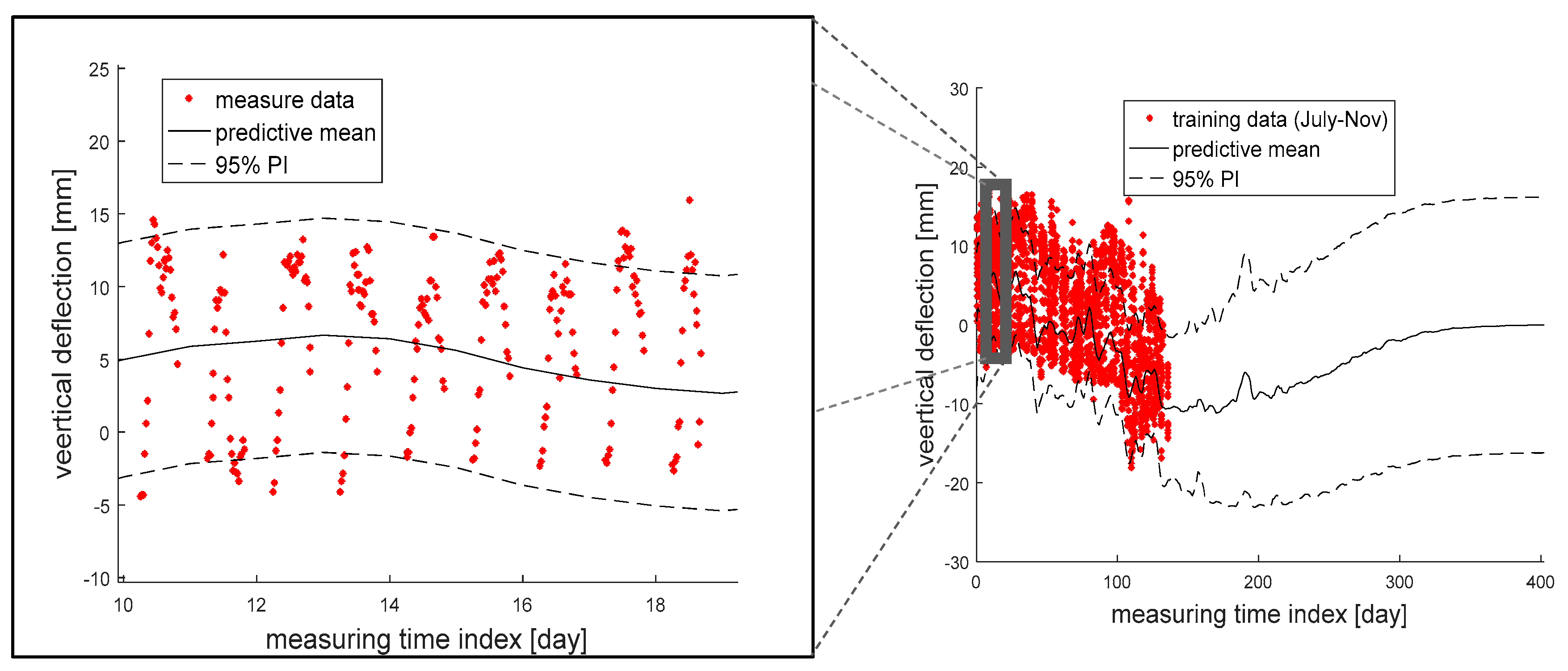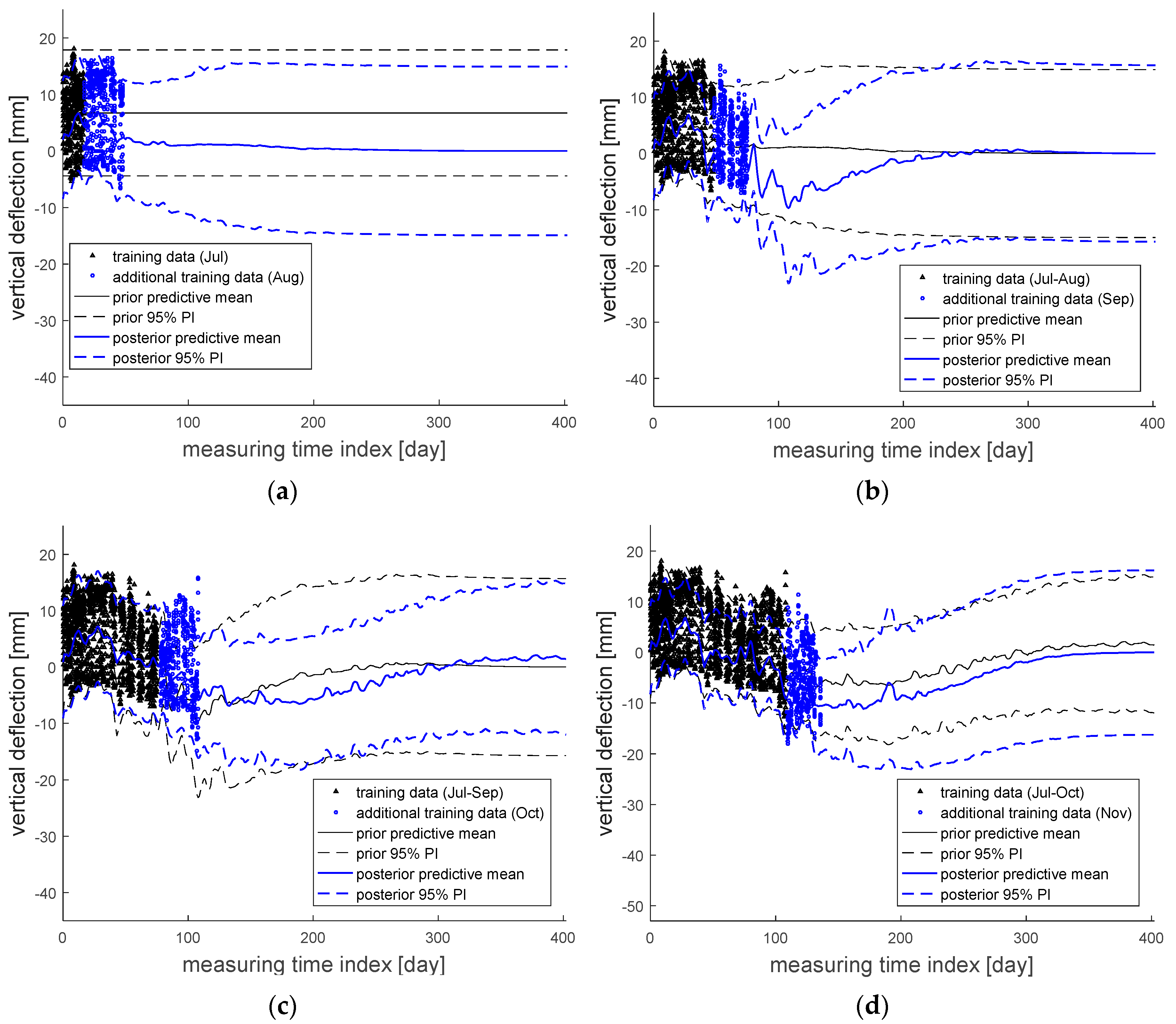2.1. Gaussian Process Regression
This research aims to construct a probabilistic model to predict the vertical deflection of a railway bridge, based on actual measurement data on vertical deflection and temperature. When a prediction model is developed, in general, there are several sources of uncertainty related to the model such as model misspecification, limited data size, and inherent variability, which are known to introduce errors of bias, model variance, and noise into the model [
28,
29]. Using the prediction error decomposition proposed by Geman et al. (1992), the expectation of a squared prediction error can be decomposed into these errors [
30]. As model variance and bias occur because of misspecification of the model or limited data size, these values are reducible. Meanwhile, noise cannot be reduced because it occurs owing to inherent variability, and it is an irreducible error [
31]. When constructing a prediction model, it is thus important to introduce an appropriate mathematical model capable of addressing these three types of errors.
In this respect, many researchers have constructed probabilistic prediction models for their engineering problems and tested these models by setting a confidence interval (CI) or a prediction interval (PI) [
32]. The term CI refers to an interval concerning only the reducible error (i.e., bias and model variance). Meanwhile, the PI considers the irreducible error (i.e., noise) in addition to the reducible error. This study aims to develop a probabilistic prediction model which can deal with both of the reducible and irreducible errors and provide prediction results with a PI about the vertical deflection of high-speed railway bridges.
To build a probabilistic prediction model, in this study, a GP is introduced. It is a machine learning-based method building a flexible Bayesian model [
33], and it requires regression analysis to identify appropriate GP parameters based on training data through optimization. The details of GPs can be found in Rasmussen and Williams (2006) [
34], and are briefly explained in this paper.
GPs are based on the Gaussian (i.e., normal) distribution, and a GP can be modeled by a regression mean and a covariance matrix, which often requires high computational costs. Despite their high costs, GPs have been widely utilized in many applications owing to their theoretical simplicity and great performance to build a probabilistic model [
34].
GPs are based on the following assumptions: (1) every data point is associated with a normally distributed random variable; and (2) the finite collection of these random variables is multivariate normally distributed, also explained as jointly normal. The multivariate normality is often introduced to explain a set of correlated random data which cluster around the mean, and it simplifies the related calculations with its definition that any sub-vector of the multivariate random variables is again a Gaussian random vector [
35]. For example, when one has a noisy training dataset
D from
ND times of measurement, which consists of a training input matrix
X and a training output vector
y, the dataset can be expressed as
where
xij is an element of the training input matrix
X, which is constructed from
ND times of observation for
Nx variables, and
yi is an element in the training output vector
y whose size is
ND by 1. Then, the two assumptions of GPs enable the prediction of the Gaussian mean and variance of the output.
For a prediction purpose, when a test input matrix
X∗ is introduced to estimate the corresponding unknown test output vector
, the combined vector of the known training output
y and the unknown test output
is expressed as the multivariate Gaussian variables:
where
N denotes the multivariate Gaussian distribution,
O is the zero matrix, which is often introduced as a prior mean function for numerical simplicity [
29,
33,
34],
∑ is the symmetric and positive semidefinite covariance matrix,
K is the covariance matrix of the training input matrix
X,
K∗ is the covariance matrix between training (
X) and test (
X∗) inputs,
K∗∗ is the covariance matrix of the test input matrix
X∗, and
is the variance of noise. In the covariance matrix
∑, noise is assumed to be independent and identically normally distributed. Because the noise exists in the test data as well as in the training data, the noise variance
is added to all diagonal terms in the covariance matrix
∑. When the sizes of the training input matrix and the test input are
ND by
NX and
NP by
NX, respectively, the sizes of the covariance matrices
K,
K∗,
K∗∗, and
∑ are
ND by
ND,
ND by
NP,
NP by
NP, and (
ND +
NP) by (
ND +
NP), respectively:
where
x and
x∗ are the 1 by
NX vectors of training and test inputs,
k(·) is an element termed the kernel in the covariance matrix
∑,
is the correlation between
xa and
xb, and
is the variance of
xa.
In Equation (3), the covariance is often modeled by a kernel function associated with the Euclidian distance between two inputs [
34], and one popular choice of the kernel considering correlation is the squared exponential (SE) kernel shown below:
where
is the variance hyperparameter of inputs which controls the vertical scale of the function change and
l is a length-scale hyperparameter that is associated with the horizontal scale of the function change [
29].
However, as shown in Equation (3), the covariance matrix
∑ requires additional variance terms for its diagonal terms (i.e.,
). This study introduces the Kronecker delta function [
34]:
where
δ(
xi,
xj) is the Kronecker delta function, which becomes one when the two inputs are the same, and zero when they are different.
In other words,
kSE and
kvar need to be introduced to construct the covariance matrix. Based on this idea, a new kernel was proposed by summing up existing kernels without any loss of properties as kernel [
34]:
where
and
are hyperparameters for non-diagonal terms,
is a hyperparameter to control the variance in diagonal terms, and
is a hyperparameter to control the level of the overall values in the covariance matrix. The kernel in Equation (6) was applied to several previous studies [
36,
37,
38], and it is introduced to this study for building the covariance matrix in Equation (3).
A GP is sensitive to these hyperparameters; thus, for the purpose of prediction, the determination of these parameters based on the given measurement data through optimization is important to build an accurate prediction model. For the task, the concept of maximum likelihood is often introduced [
28].
Regarding Equations (1) and (2), the likelihood of observing the training output vector
y given the training input
X can be expressed as a conditional probability using the multivariate normal distribution as follows:
For numerical convenience, the natural logarithm is introduced for conditional probability and is multiplied by minus one:
where
L is the log-likelihood function. The three terms on the right in Equation (8) represent the three errors in the prediction model described in
Section 2.1 (i.e., the bias, model variance, and noise).
Then, the best hyperparameters
can be determined through optimization to minimize the sum of these errors (i.e., the log-likelihood function
L in Equation (8)):
Since the conditional probability was multiplied by minus one as shown in Equation (8), obtained from the minimization problem in Equation (9) become the parameters which maximize the likelihood of observing the training output vector y given the training input X.
Once the hyperparameters are identified using Equation (9), the kernel in Equation (6) is constructed. Then, the optimal covariance matrix in Equation (3) is composed and the mean and the variance vectors of the test inputs can be calculated by the property of the multivariate Gaussian distribution. Based on the derivation by Muirhead (2009), given test input
X∗, the conditional multivariate Gaussian distributions of the test outputs
are estimated as follows [
39]:
Using Equation (10), the predictive mean and the PI can be estimated.












